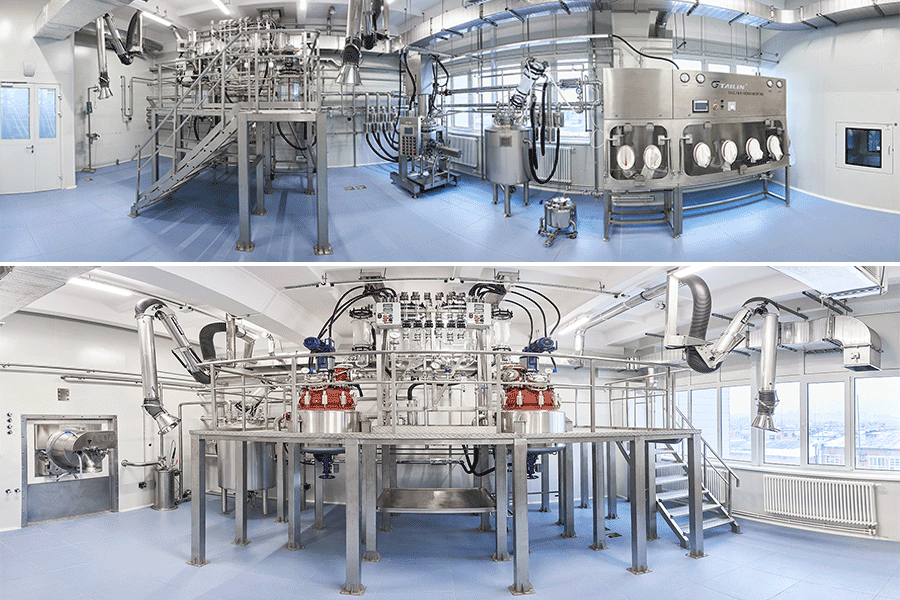API MANUFACTURING FACILITY (5000 KG/Y)
Customer: LLC «NATIVA»
Objective: advanced design, supply of equipment, installation and commissioning for three production sites of purification, drying and packaging of APIs.
The facility is placed on the 5th floor of a building. It consists of three production sites:
• The first site is to produce hormonal APIs. The size of one batch is from 2 to 6 kg. Substances for exposure to personnel are OEB4 (OEL = 10 μg/m3 of working area air).
• The second site is to produce cytotoxic APIs. The size of one batch is from 5 to 20 kg. Substances for exposure to personnel are OEB4 (OEL = 10 μg/m3 of working area air).
• The third site is to produce non-toxic APIs. The size of one batch is from 5 to 20 kg. Substances for exposure to personnel are OEB2 (OEL > 1000 μg/m3 of work-ing area air).
There were several major tasks during the implementation of this project:
• Place equipment in limited space.
• Ensure staff protection from the exposure to manufactured APIs.
• Ensure that manufactured APIs are not in contact with stainless steel during the hot filtration stage (for first and second production sites).
• Ensure a gravity flow of slurry to a filter dryer or centrifuge.
• Place circulation thermostats, control boxes and other equipment with protection level lower IP54 in a technical area.
To solve these tasks REATORG LLC completed the following works:
1. Made a BIM-model of the future facility and detailed design documentation for each production site and utilities (purified water, clean nitrogen, compressed air, vacuum, hot and cold silica oil, breathing, feed lines and etc).
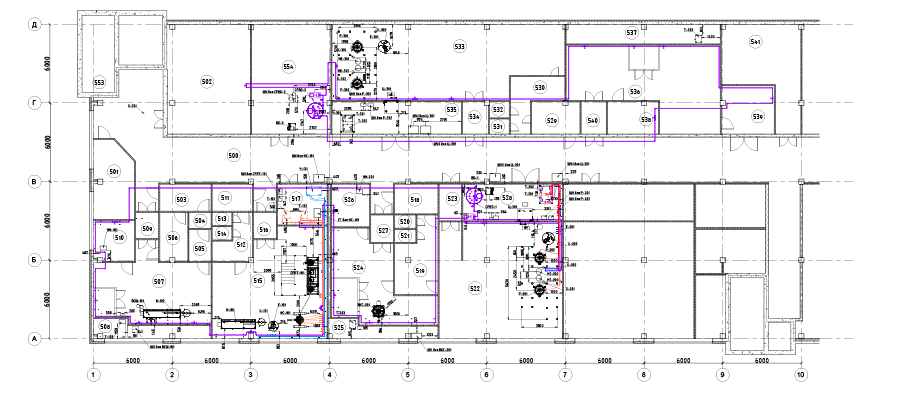


2. Designed, manufactured and supplied their own process equipment under trademark REATORG TECHNOLOGIESTM.
A reactor system based on glass vessels for dissolving, filtration and crystallization of APIs was designed, manufactured and installed for the first production site.
The reactor system consists of two glass jacketed vessels with 50L working vol-ume, anchor-type agitators made from PFA covered steel, two 25L measuring vessels (one of them with a cooler coil inside), 0.75 m2 reflux condensers, two PTFE filter housings with PTFE filters for hot filtration. Reactors are connected to thermostats (PT100 sensors are connected to thermostats for precise temperature control), to a vacuum line through reflux condensers, to nitrogen and breathing lines. Rapture disks were installed to protect glass vessels from over-pressure. There is borosilicate glass 3.3, PTFE, PFA and tantalum (a membrane covering of a vacuum and pressure gauge) in a contact with media. All materials have certificates. Control boxes are placed in a technical area, but Ex-proof control panels are installed next to reactors. 
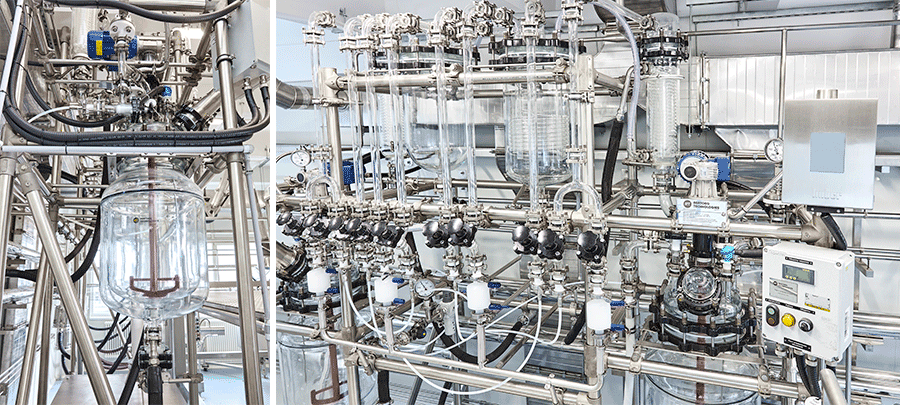
For the second production site, Reatorg's 3D-engineers designed a reactor system based on two glass-lined reactors Pfaudler AE160 with glassware equipment by REATORG TECHNOLOGIESTM. This system is intended for dissolving, filtration and crystallization of APIs.
The system includes two 100L glass measuring vessels, two 1.5 m2 reflux condensers, glass tubes for connection to vacuum, nitrogen and breathing lines and for charging organic solvents into measuring vessels. To prevent damage of glassware equipment due to overpressure reactor nozzles are equipped with PTFE-lined butterfly valves. PFA lined fittings and hoses were used to connect utilities to reactors and for connecting them to each other. Control boxes are placed in a technical area, but Ex-proof control panels are installed next to reactors. 
To provide production sites purified water, two systems for storage and distribution of PW were designed and installed. Each system consists of a tank for storage purified water (2 m3), a circulation pump, a UV lamp, membrane valves, a stainless-steel distribution loop. The quality of water is controlled by a conductivity sensor and the needed flow rate is maintained by the sensor of flow velocity that connected to a frequency converter of the circulation pump.
3. Selection, adaptation and supply of technological equipment of foreign suppliers.
Filter dryer (FD) for the first production site. The FD is made of 316L stainless steel, the working volume of 75 liters. Following the FAT, Reatorg's and AGT's mechanical engineers developed a new mixer design with fluoroplastic liners to optimize product discharge from the dryer.
For the final drying of the product at the first production site, a unit was designed that combines a vacuum drying oven attached to a negative pressure isolator. Reatorg's specialists developed a joint flange and control system for the vacuum dryer.
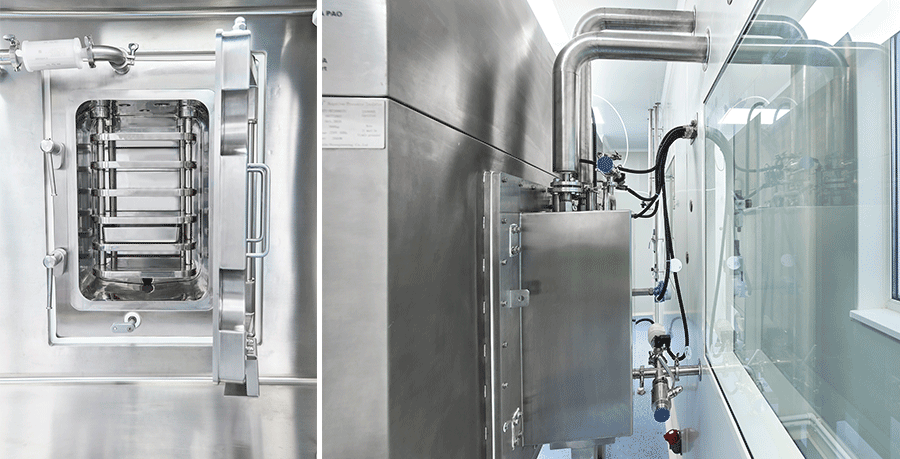
ComiCondor horizontal filtering centrifuges were supplied and mounted for the second and third production sites. For the installation of centrifuges, structural steel platforms with an anticorrosive coating were designed and manufactured.
For the third production site, titanium reactors with a working volume of 200 liters were designed and supplied. The reactors are completely made of titanium Grade 2. The reactors are equipped with a jacket, an anchor stirrer, a manhole with a sight glass, and JohnCrane’s dry double mechanical seal. Reactors are designed to operate under pressure. 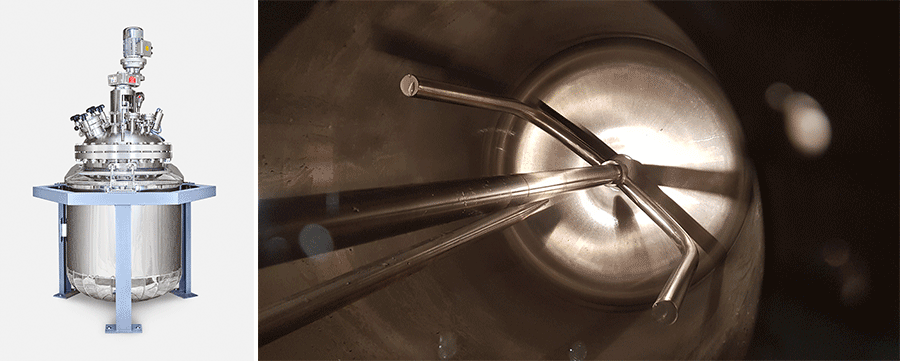
Huber thermostats were selected, supplied and mounted for all production sites.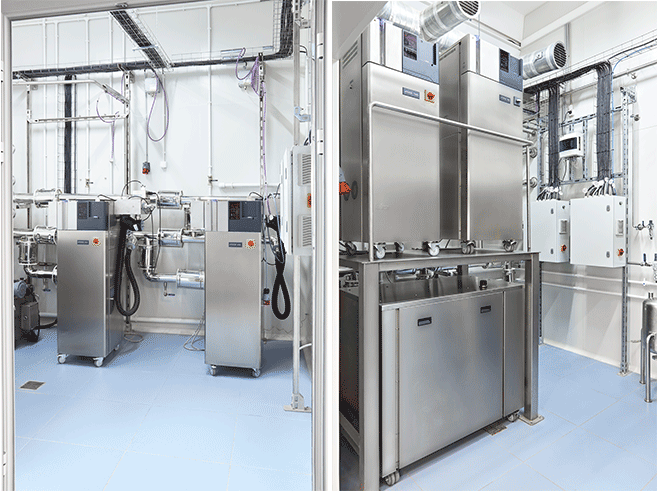
A vacuum conical dryer with a working volume of 150 liters was selected, delivered and installed for the second production site. The dryer is made of 316L stainless steel, equipped with a spiral mixer for stirring the product and lifting it along the heated walls. The vacuum nozzle is equipped with a filter with reverse nitrogen purge for cleaning. A pulse nitrogen valve was installed for the proper mixing of the product. A hemispherical bottom valve provided good discharging of the product.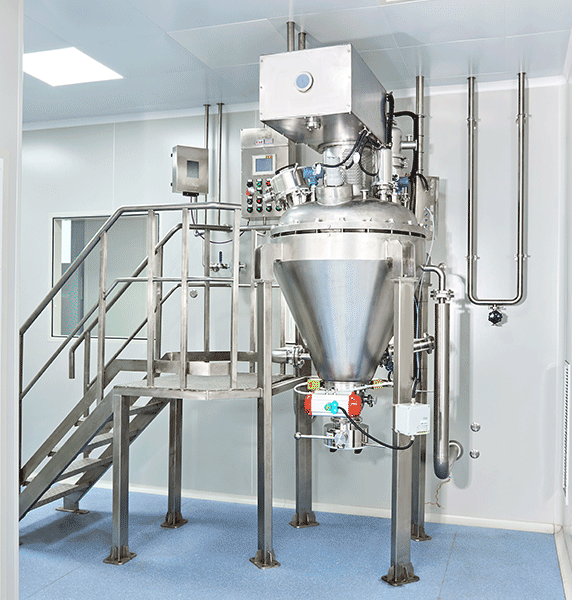
For all production sites, receiving tanks for filtrate from a filter dryer and centrifuges were installed. Receiving tanks are equipped with borosilicate glass condensers through which vessels are connected to a vacuum line.
For cleaning equipment at all sites, a mobile CIP-station was designed and supplied, which consists of 2 containers of 150 l each for washing solutions, a solution supply pump, a circulation pump with a filter (for protection against solid particles washed off from the equipment), diaphragm metering pumps for deter-gents, 10 kW flow heater.
4. Solutions for staff protection from the exposure of produced APIs;
To protect staff from the exposure of manufactured substances, local air extraction systems were organized in all three sites. At the first and second sites, where highly active substations are manufactured, isolators and ChargePoint split-valves were used. Applied technologies allow working with dry powders of HPAPI up to substances with OEB4 (OEL = 10 μg / m3 of working area air).
A negative pressure isolator with an anti-vibration platform for scales for raw materials. The isolator is equipped with a PharmaSafe valve to fill the raw materials into the IBCs.
Reactor loading nozzles equipped with PharmaSafe active valves.
Discharge nozzles of the centrifuge and the filter dryer equipped with PharmaSafe active valves. 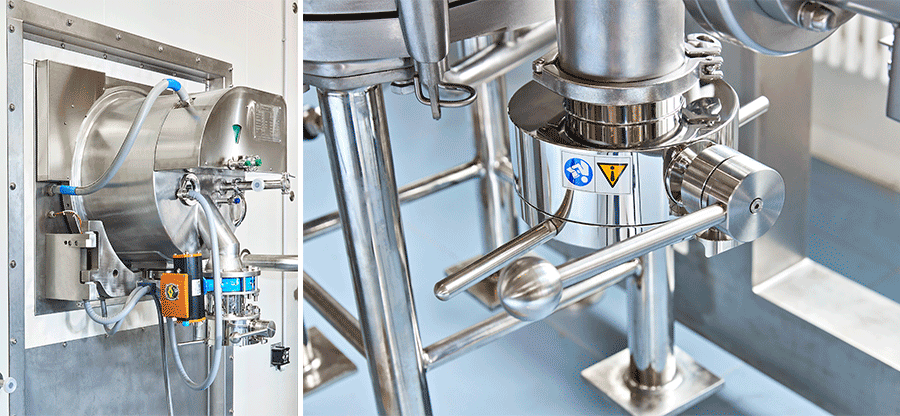
The negative pressure isolator with embedded vacuum drying oven and DN100 nozzles with PharmaSafe active valve to charge dry powder into IBC and transfer it to a mill. 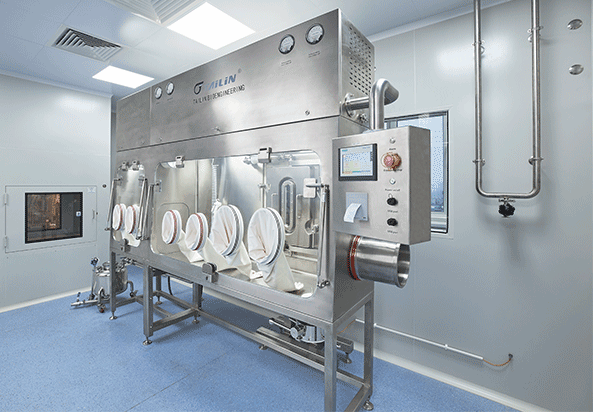
Charging and discharging nozzles of the vacuum conical dryer with PharmaSafe valves. 
5. Installation of process pipelines, including clean media pipelines (purified water, nitrogen);
Reatorg’s own installation team laid about 1000 m of stainless steel process pipelines - silicone heat transfer fluid, vacuum, nitrogen, compressed air, purified water, breathing, feeding lines. The pipe supports were made of stainless steel, more than 50 penetrations through walls and ceilings (including clean-rooms) were made, thermal insulation and shielding of heat transfer fluid pipe-lines were made, X-ray inspection of welded joints of categorized pipelines (by a specialized organization ) was carried out, conducted pneumatic tests for strength and tightness; pipelines was flushed with water.
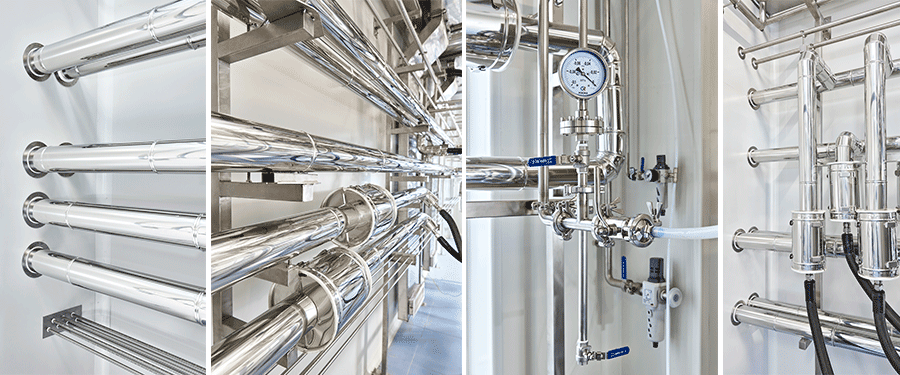

6. Installation and piping of technological equipment.
Stainless steel service platforms for process equipment were designed, delivered and installed.

Piping works for equipment were made, including a centrifuge. Due to vibration during operation, process fluids and product lines to the centrifuge must be connected using hoses or flexible joints.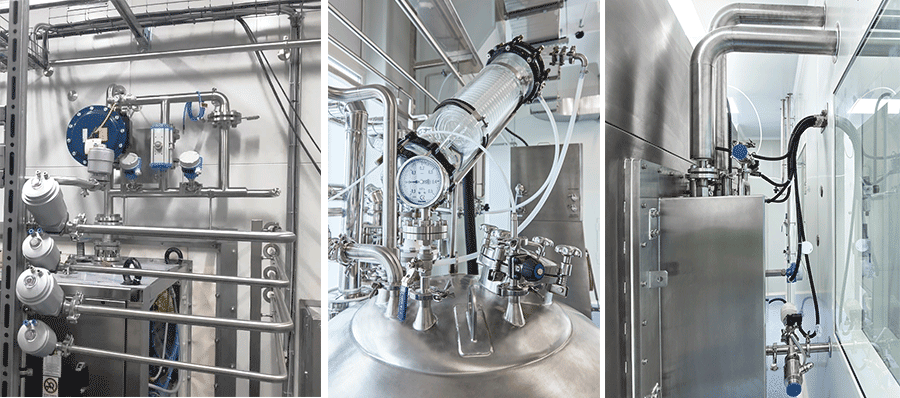

Cable trays were installed, power and signal cables were laid, control boxes and HMI panels were installed.

7. Commissioning.
8. Equipment qualification (for several units).
The list of equipment:
- Reactor systems REATORG TECHNOLOGIESTM
- Filter-dryers
- Isolators
- Centrifuges
- Thermostats
- Vacuum conical dryers
- ChargePoint split-valves





